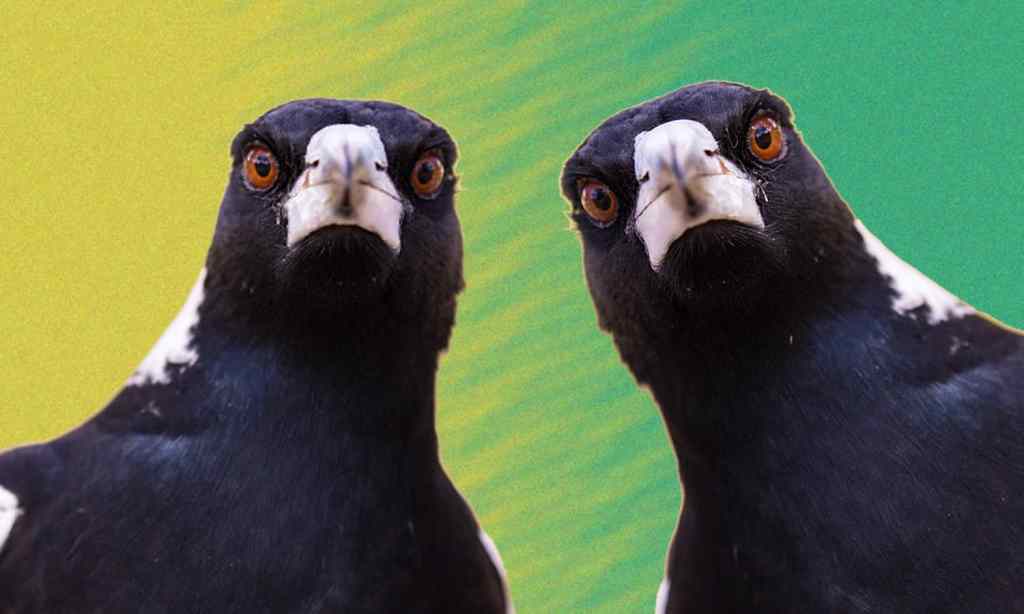Ah, it’s swooping season again. Just one of the many instances of everyday Australian life that any outsider would struggle to believe is real and probably chalk up, along with drop bears, as something we’ve made up for a laugh. Until they get swooped.
Swooping season is the bane of cyclists everywhere and the only time that an ice cream container is acceptable headgear. Moreover, the ABC has reported that an Adelaide magpie specifically picked on one footy player in a match this year.
But magpies are not bloodthirsty monsters out for revenge, and only some of them swoop. Much like many animals, spring is the hatching season for magpies and the protective birds are simply trying to ward off possible threats to their young.
Here’s everything you need to know about magpie swooping and how best to avoid it.
Why Magpies Swoop
Magpies are highly intelligent native Aussie birds who are just trying their hardest to raise their young in a tough environment. Therefore, magpies have a responsibility, no, a duty, to swoop.
Only male magpies swoop and only about 10 per cent of them actually swoop people. They only do so for around six weeks when their partner is sitting on the nest or raising her chicks until they are big enough to leave the nest and fend for themselves. That’s usually late August to mid-October.
During this time, the male will swoop anyone and anything that comes within about 50 metres of the nest that looks like a threat. Unfortunately, that sometimes includes people.
Magpies rarely make contact and usually just use their body language to scare predators off. That means they’ll come in low for a good swoop and snap their beaks at an intruder, screeching as they go.
There have been instances of magpies making contact with people as they swoop and the birds are big and strong enough to draw blood with their beaks and claws.
Some have even caused fatalities, with magpie attacks causing cyclists or drivers to swerve and crash. Recently, one mother tragically lost her 5-month-old baby due to a magpie attack.
According to information published by the ACT government, most magpies don’t actually see humans as a threat and are unlikely to swoop at all.
Magpies that do swoop are likely to have experienced past trauma or harassment.
Being highly social and intelligent birds, they can recognise up to 100 different people by looking at them. If you’ve ever done anything that might make a magpie think you’re a threat — like coming too close to their nest — or just look like someone who has, you could be in for a swooping.
As the Bush Capital, Canberra actually has the highest number of swooping incidents. Scientists there saw a dramatic increase in swooping in 2020 which they put down to mask-wearing.
The use of face masks appears to have disrupted the magpie’s ability to tell friend from foe and thus they’re swooping everyone just for good measure. It’s thought that we could expect higher incidents of swooping this year as facemasks are now mandatory across much of the country.
How to Avoid Being Swooped by A Magpie
Unfortunately, there’s not a whole lot you can do to avoid being swooped as the magpies that are determined to swoop generally won’t be deterred.
However, there are a few things you can do that will lessen your chance of becoming a target and a few things not to do if you become one.
When moving through known swooping territory, it’s best to move quickly but calmly. Some people think bright colours will deter a magpie which is worth a try.
If you’re actively being swooped, get out of there fast but don’t run or try to hit the magpie back — this will only anger it and lock you in as a target. As you walk away, face the magpie and or its nest as they don’t seem to like attacking from the front.
Protect your head as much as you can, possibly with an umbrella, large hat, or helmet. Use sunglasses to keep your eyes safe.
Travelling in groups also seems to help as magpies like to go for solo individuals.
Don’t wave your arms, shout, or act aggressively as the magpie will definitely consider you more of a threat.
Don’t offer them food as they can learn to associate swooping with food.
It’s against the law to kill or interfere with a magpie so if there is a problem magpie in the area, the best thing you can do is avoid it.
Some neighbourhoods will put up signs with information on swooping magpies in the area. Victoria has an interactive map of known swooping sites and the website MagpieAlert also lets you notify others of swoopy boys in the area.
Read more stories from The Latch and subscribe to our email newsletter.

